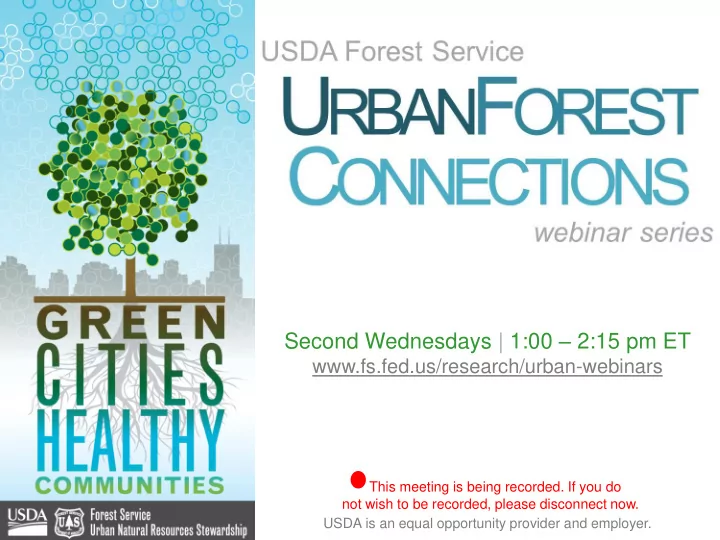

Second Wednesdays | 1:00 – 2:15 pm ET www.fs.fed.us/research/urban-webinars This meeting is being recorded. If you do not wish to be recorded, please disconnect now. USDA is an equal opportunity provider and employer.
Lara Roman Yekang Ko Pete Smith Research Ecologist Assistant Professor, Urban Urban Forestry Program Manager USDA Forest Service Planning Arbor Day Foundation University of Texas, Arlington
Monitoring urban trees: Survival, growth, and energy-saving performance US Forest Service Urban Forest Connections Webinar March 9, 2016 Lara Roman Yekang Ko Pete Smith US Forest Service UT Arlington Arbor Day Foundation
Outline • Introduction – Why study tree mortality? – Why study yard trees? • Part I: Sacramento Shade 5-year study • Part II: Sacramento Shade 22-year study • Part III: Energy-Saving Trees program
Mortality rate assumptions • Million Trees LA cost-benefit analysis – High morality scenario : 5% years 1-5, 2% years 6+ – Low mortality scenario : 1% years 1-5, 0.5% years 6+ After 35 years: High mortality : 58% dead Low mortality : 18% dead McPherson et al. (2008) McPherson (2014)
Why study tree mortality? • Mortality assumptions affect cost-benefit calculations • Plan ahead for tree removal and replacement • Target program improvements for at-risk trees Roman (2014) Roman et al. (in press)
Why study yard trees? • Yards and lawns are the primary point of contact between urban residents and nature • Yard tree distribution programs operate quite differently from street tree planting programs – Private land (not public right-of-way) – Rely on residents for tree care • Yard tree planting is essential to meet canopy cover and planting campaign goals
Residential urban tree canopy city year % existing % residential % possible % residential source canopy out of total additional out of possible existing canopy canopy additional canopy Baltimore, 2007 27% 41% 44% 27% O’Neil -Dunne MD (2009) New York 2010 21% 28% 44% 35% O’Neil -Dunne City, NY (2012) Philadelphia, 2008 20% 23% 49% 24% O’Neil -Dunne PA et al. (2011) Providence, 2007 23% 62% 53% 47% City of RI Providence (2008) Nguyen et al. (in preparation) UTC summary courtesy of D.H. Locke
Part I: Sacramento Shade 5-year study Lara Roman, US Forest Service
Sacramento Shade program • Reduce energy use through tree shade • 500,000 trees given away since 1990
Sacramento Sacramento Tree Municipal Utility Residents Foundation (STF) District (SMUD) Program implementation Funding Tree planting Community foresters Quality Assurance Maintenance
5-year survival study goals • Assess tree survival during establishment phase • Evaluate risk factors for tree death Study sample: 13,594 trees 436 single-family delivered in 2007 residential trees Roman et al. (2014)
Defining terms • Annual survival rate Proportion of individuals surviving each year annual survival = # alive (T+1) # alive (T) • Annual mortality rate Proportion of individuals dying each year annual mortality = 1 – annual survival
Defining terms (cont.) • Survivorship Proportion of individuals surviving out of those planted survivorship to time T = # alive (T) # planted • Survivability Proportion of individuals surviving out of those distributed survivability to time T = # alive (T) # distributed
Trees delivered 2007 75% survivability Planted Not planted 85% 15% Alive 2008 Dead 2008 88% 12%
1.0 0.8 0.6 survivorship survivorship survivorship 0.4 71% survivorship (5 yrs) 6.6% annual mortality 0.2 0.0 0 1 2 3 4 5 0 500 1000 1500 2000 time (years since planting) time time (years since planting)
Planting status • Educational attainment ( ↓ education, ↓ planted) • Homeowner stability (↓ stable, ↓ planted)
5 year survival • Homeowner stability (↓ stable, ↓ survival) 1.0 stable: 5.2% annual mortality 0.8 survivorship 0.6 Survival unstable: survivorship 9.3% annual mortality 0.4 0.2 stable homeownership PropertyStable2007Last=stable unstable homeownership PropertyStable2007Last=unstable 0.0 0 500 1000 1500 2000 time (days since planting) time (days since planting) time
Conclusions • Observed mortality > assumed mortality • Most trees lost in the first year – Failure to plant – 1 st year mortality • Many residents do not follow recommended maintenance practices • Importance of stable homeownership
Recommend
More recommend